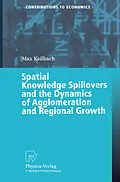When considering the dynamics of regional growth rates, one usually observes growth convergence on spatial aggregates but non-convergence or even divergence within smaller regions of different type. This book suggests various approaches to investigate this puzzle. A formal model, merging approaches from growth theory and new economic geography, shows that spatial knowledge spillovers might be the driving force behind this behavior. To analyze an arbitrary number of regions, the model is implemented on a locally recursive simulation tool - cellular automata. Convergence regressions from different runs of the automaton confirm previous findings. Finally, the existence of spatial knowledge spillovers is tested. Regressions give strong evidence for spatial knowledge spillovers. All the relevant literature and spatial econometric methods are surveyed. Data is reproduced in the appendix.
Klappentext
and Feldman, 1996 or Audretsch and Stephan, 1996) show that unformalized knowledge may playa major role in the innovation of new products. Now if unformalized knowledge is communicated personally, distance will be an important variable in this process, since the intensity of contacts between persons can be expected to be negatively correlated to the distance between them. In the discussion of section 3.3.1 (page 42) we saw that it was this aspect of localization that Marshall had in mind when he was alluding to "local trade secrets".4 Note that if this spatial dimension of communication between agents exists, it is possible to transfer it to regional aggregates of agents: the closer two regions, the more they will be able to profit from the respective pool of human capital (R&D-output etc.) of the other region. This argument gives a spatial 5 interpretation of the literature on endogenous growth. Now if these spillovers have a spatial dimension then it follows from the discussion in chapter 3 that they will be one driving force in the dynamics of agglomeration. With the model to be developed in this chapter I will investigate the hy pothesis that it is these forces of agglomeration (i.e. spatial spillovers of nonrival goods or foctors) that are responsible for the inhomogeneous pattern of growth con vergence. To analyze this phenomenon, I consider different types of regional aggregates and different distances in the model.
Inhalt
Introduction and Motivation: Background of the Analysis; Contribution of the Book.- Why and How Does Economic Activity Grow? An Overview of the Literature: Introduction; A Summary of the Neoclassical Growth Theory; Implications of the Neoclassical Growth Thory for Regional Growth; Summary and Conclusion.- Why and How Does Economic Activity Concentrate in Space? Another Overview of the Literature: Introduction; The Role of Transportation Costs; The Role of Spatial Externalities in Production; Summary and Conclusion.- Spatial Knowledge Spillovers and the Dynamics of Agglomeration and Regional Growth: Introduction; Positive External Effects in Production. Properties and Implementation; The Model; Marshallian Externalities and the Convergence of Regions; Summary and Conclusion.- Marshallian Externalities, Spatial Self-Organization and Regional Growth - An Agent-Based Approach: Introduction; Who Organizes the Economy? Cellular Automata as a Tool for Modelling Local Economic Interaction; Local Interaction and the Dynamics of Agglomeration; Simulation Results; Summary and Conclusion.- Spatial Processes in the Economy - An Empirical Investigation: Introduction; Data: Sources and Construction; Spatial Econometrics - An Overview; Empirical Implementation of the Model and Results; Summary and Conclusion .- Summary and Conclusion: Generalization of the Model Developed in Chapter 4; Mathematical Appendix; Data .
